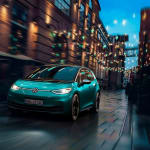
Such a warm welcome! As if blinking its eyes, the car awakes as soon as its driver comes closer, lighting up and turning its light module towards them. This is the welcoming scenario awaiting you when walking up to the Volkswagen ID.3. The compact car is the first model in the fully electric ID family that represents the electromobility segment and the transition towards autonomous driving at the world’s largest automobile manufacturer.
“We want to lead the way for electromobility through attractiveness,” says Urs Rahmel, Chief Designer of the Exterior Design Studio at Volkswagen. One example is the idea that customization options will increase the owner’s attachment to the vehicle and extend its period of use. This poses high demands on technology, design and materials. “In this context, Plexiglas molding compounds from Röhm can contribute to future-oriented automotive design, especially when combined with light,” emphasizes Siamak Djafarian, Head of the Molding Compounds business unit at Röhm GmbH.
Award-winning design
Prior to its market launch in the summer of 2020, the ID.3 had already won several design awards. At the internationally renowned “Automotive Brand Contest 2020”, it received the “Best of Best” award in the categories “Exterior Volume Brand” and “Interior Volume Brand”. By the way, the Plexiglas molding compound campaign that conveys the material’s properties for automotive design was the “Winner” of this competition by the German Design Council two years ago.
Light makes cars appear human
Light is not only an important design component when it comes to future mobility, but also has additional functions, such as displaying information on the charging process and charging status of electric vehicles. On the exterior, it provides safety and aids in communication with other road users with lighting also representing the brand identity and creating a wave of enthusiasm for the vehicle. According to VW designers, it is conceivable to provide customers with access to customizable light animations which can be downloaded in the future.
“I am always touched how light creates an emotional attachment between humans and cars,” says Sandra Sturmat, who designs how light behaves in the Volkswagen User Experience Design Team. For example, “opening its eyes and looking at you” are typical characteristics of the Volkswagen ID family. An innovation in the lighting concept is an LED light strip which stretches from the headlights to the VW logo. It highlights the width of the vehicle and fits seamlessly into the exterior lines. This light strip is also part of the new Volkswagen light signature for all models which gives modern mobility a friendly face.
Plexiglas Resist AG 100 used in light design
The LED light strip can already be seen in some of the vehicles in the Golf 8 model range. The versatile properties of Plexiglas Resist AG 100 come to the fore in the light strip cover: “This special molding compound is extraordinarily impact-resistant and simultaneously boasts higher heat resistance, excellent UV and weather resistance as well as uncompromisingly good optical properties,” explains Dr. Sivakumara Krishnamoorthy, Senior Product Manager Automotive in the Molding Compounds business unit at Röhm GmbH.
Dr. Eugen Fichter, expert for materials technology at Volkswagen is also impressed with the material. “Both vehicles represent renewal and innovation – the Golf when it comes to conventional drivetrains and the ID.3 in electromobility, making them flag bearers of this innovative material.” Fichter also points out that requirements regarding quality and functionality of plastics are constantly increasing in the field of automotive construction. Extremely durable plastics with a high-quality surface appearance are in demand. In Plexiglas Resist AG 100, the polymer expert particularly appreciates the resistance to stress cracking and impacts.

“Light inspires trust”
The next major innovative leap in mobility is autonomous driving. Communication between the vehicle and pedestrians is one of the challenges automotive developers are faced with in this context. “Not having eye-contact unsettles pedestrians, as the driver may be occupied with something else while the car is driving autonomously,” points out light designer Sturmat. The solution? “Light design inspires trust!” Eye-contact is replaced with light signals which the vehicle uses to indicate whether it will stop, start moving or make a turn.
“This requires robust transparent and translucent plastics with which information can be imparted to pedestrians,” adds Fichter. “Another aspect is the protection of sensors in autonomous driving, as they should be invisible but still function reliably.”
Plexiglas molding compound: Materials for autonomous mobility
Special Plexiglas molding compounds are available for both applications. The brand PMMA in a neutral gray creates a black-panel effect. This enables the fabrication of functional components that elegantly fit into the design as glossy black panels, and transform into multi-functional light signals when needed. The impact resistant and high-gloss black Plexiglas Hi-gloss NTA-5, for example, is suitable as a cover for sensors, as it has low radar absorption, is fully colored and does not require coating, while Plexiglas 8N 90114 is an infra-red-transparent material for IR and LIDAR applications.
Automotive manufacturers value durable and sustainable plastics
Alongside function and aesthetics, sustainability is becoming ever more important. “As increasing amounts of plastic are used, it is essential that they are reusable. Materials such as Plexiglas have enormous potential here as PMMA can be mechanically or chemically recycled,” says Fichter. This only becomes necessary once the car has served its purpose, as the brand PMMA by Röhm is a high-quality and durable material which retains its properties throughout the vehicle’s lifespan – and in its original state, as the chemical structure of PMMA means its inherent UV-resistance is so high that subsequent coating is unnecessary.
Volkswagen consistently pursued the principle of sustainability in the ID.3. The electric car is the first model by the leading automotive manufacturer that was manufactured in a CO2-neutral manner. The climate-neutral packaging in which Röhm delivers its Plexiglas molding compounds also makes a small contribution to this.


